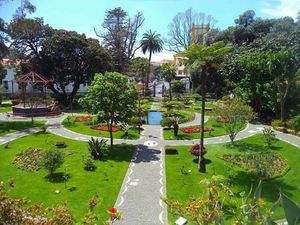
Duque da Terceira Botanical Garden
Do not miss the chance to visit the Duque da Terceira Botanical Garden on your way through Angra do Heroísmo, Terceira Island, Azores
The Jardim Botânico Duque da Terceira (Duque da Terceira Botanical Garden) is one of the most beautiful gardens in the Azores. It is located near the Franciscan and Jesuit Convent, in the city centre of Angra do Heroísmo, in Terceira Island, Portugal.
It was created in 1882 at the initiative of the Civil Governor Afonso de Castro, occupying an area of 17,500 square kilometres. Nowadays it still preserves interesting testimonies of the old fence of the Franciscan Convent, such as the Tanque do Petro with its black statue of a Brazilian Indian playing music; or the compound of four tiles panels from 1740 representing rustic environments and domestic scenes of the time.
This garden owes its original style to the Belgian astronomer Francisco José Gabriel, even though from its beginning different styles were applied to it, such as the English Romantic or the French Geometric.
During its construction it was designed to be a public promenade, but it ended up being a climatised garden due to the characteristics of the Azores roof, which provides exceptional conditions for the growth of plants from all over the world.
Currently the garden hosts a great variety of botanic species among which stand out the coffee plants, the eucalyptus, araucarias, dragon trees, Persean American with avocados, tiles, and laurels, organised along a nice road which lead to Alto da Memória, a spectacular viewpoint over the city where it is located an obelisk-shaped monument built between 1845 and 1856 to honour D. Pedro IV.
Other interesting places inside the garden are: Caramanchão, Almeida Garret Square, Correto, Babão, iconographic reproductions of the calçada do Duque da Terceira, Almeida Garret and Vitorino Nemésio Sidewalk; the heater, Manuel António bust, and the ruins of the former watermill.
More Information:
Location:
Praça Velha, Angra do Heroísmo, Terceira Island, Azores.
Telephone:
(+351) 2995 212 131.
Mapa Interactivo:
Terceira Island
What to see:
- Angra do Heroísmo
- Igreja da Misericórdia
- Angra do Heroísmo Museum
- Angra do Heroísmo Cathedral
- Palácio dos Capitães Generais
- Paços do Concelho
- Duque da Terceira Botanical Garden
- Praia da Vitoria
- Miradouro do Facho Viewpoint
- São Mateus da Calheta
- Biscoitos (Natural Pool)
- Wine Museum of Biscoitos
- São Sebastião
- Algar do Carvão
- Furnas do Enxofre
Why "Portugal Travel"?
Portugal Travel is an organization of Portuguese agencies whose objectives are:
- ✓ To make Portugal, its culture and its heritage known.
- ✓ To promote sustainable tourism.
In collaboration with:
Escola Superior de Hotelaria e Turismo do Estoril
Turismo de Portugal
Copyright PortugalTravel.org © - All rights reserved.




